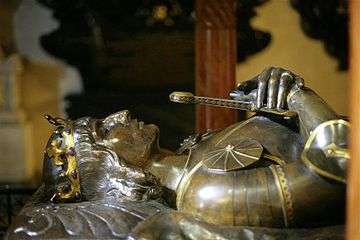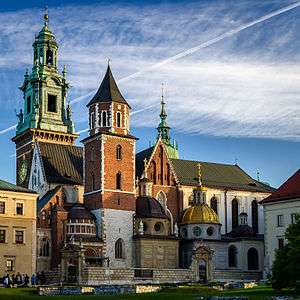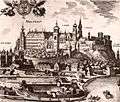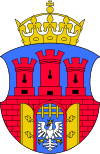Wawel Cathedral
| Wawel Cathedral Królewska Bazylika Archikatedralna ŚŚ. Stanisława i Wacława na Wawelu | |
|---|---|
|
Wawel Cathedral on Wawel Hill: Sigismund's Chapel (right, with a gold dome) and Vasa Dynasty chapel (to the left) | |
| Basic information | |
| Location | Kraków, Poland |
| Geographic coordinates | 50°03′17″N 19°56′07″E / 50.0546°N 19.9354°ECoordinates: 50°03′17″N 19°56′07″E / 50.0546°N 19.9354°E |
| Affiliation | Roman Catholic |
| Province | Archdiocese of Kraków |
| Ecclesiastical or organizational status | Royal Arch-cathedral Basilica |
| Status | Active |
| Architectural description | |
| Architectural type | Church |
| Architectural style | Romanesque, Gothic, Renaissance, Baroque |
| Completed | 11th century |
The Royal Archcathedral Basilica of Saints Stanislaus and Wenceslaus on the Wawel Hill (Polish: królewska bazylika archikatedralna śś. Stanisława i Wacława na Wawelu), also known as the Wawel Cathedral (Polish: katedra wawelska), is a Roman Catholic church located on Wawel Hill in Kraków, Poland. More than 900 years old, it is the Polish national sanctuary and traditionally has served as coronation site of the Polish monarchs as well as the Cathedral of the Archdiocese of Kraków. Karol Wojtyla, who in 1978 became Pope John Paul II, the day after his ordination to the priesthood, offered his first Mass as a priest in the Crypt of the Cathedral on 2 November 1946, and was ordained Kraków's auxiliary bishop in the Cathedral on 28 September 1958.[1]
The current, Gothic cathedral, is the third edifice on this site: the first was constructed and destroyed in the 11th century; the second one, constructed in the 12th century, was destroyed by a fire in 1305. The construction of the current one began in the 14th century on the orders of bishop Nanker.
Interior
The Cathedral comprises a nave with aisles, transepts with aisles, a choir with double aisles, and an apse with ambulatory and radiating chapels. The main altar, located in the apse, was founded about 1650 by Bishop Piotr Gembicki and created by Giovanni Battista Gisleni. The altar painting of Crucified Christ by Marcin Blechowski is from the 17th century.[2] Over the main altar stands a tall canopy of black marble supported by four pillars, designed by Giovanni Battista Trevano and Matteo Castelli between 1626 and 1629. Underneath the canopy is placed a silver coffin of national patron saint St. Stanislaus (Stanisław) created between 1669-1671 after the previous one (donated in 1512 by King Sigismund I the Old) was stolen by the Swedes in 1655.[3]
 The main gilded altar established in about 1650 |
 Cenotaph of king Władysław of Varna |
 Tomb of king Casimir III the Great |
 Sarcophagus of St. Stanislaus |
Sacristy |
Chapels and burial chambers
The Wawel Cathedral has been the main burial site for Polish monarchs since the 14th century. As such, it has been significantly extended and altered over time as individual rulers have added multiple burial chapels.
Sigismund's Chapel, or Zygmunt Chapel ("Kaplica Zygmuntowska"),[4] adjoining the southern wall of the cathedral, is one of the most notable pieces of architecture in Kraków and perhaps "the purest example of Renaissance architecture outside Italy."[4] Financed by Sigismund I the Old, it was built between 1517 and 1533 by Bartolommeo Berrecci, a Florentine Renaissance architect, who spent most of his career in Poland.
A square-based chapel with a golden dome, it houses the tombs of its founder and those his children, King Sigismund II Augustus and Anna Jagiellon (Jagiellonka).
 The iconic three towers: Sigismund Tower, Clock Tower, and Silver Bell Tower |
 Main gate between the Holy Cross Chapel (right) and Holy Trinity Chapel (left) |
 Vasa chapel |
Holy Cross chapel |
 Entrance to the Wawel cathedral, from the west |
St. Leonard's Crypt beneath the Cathedral
The crypt beneath the Wawel Cathedral holds the tombs of Polish kings, national heroes, generals and revolutionaries, including rulers of the Polish-Lithuanian Commonwealth such as Jan III Sobieski and his consort Marie Casimire (Maria Kazimiera), the remains of Tadeusz Kościuszko – the leader of a Polish national insurrection and Brigadier General in the American Revolutionary War; the national bards: Adam Mickiewicz (laid to rest there in 1890) and Juliusz Słowacki (1927), as well as Władysław Sikorski – Prime Minister of the Polish Government in Exile and Commander-in-Chief of the Polish Armed Forces, along with Marshal Józef Piłsudski – founder of the Second Polish Republic.[5] Pope John Paul II considered being buried there also at one point in time, while some of the people of Poland had hoped that, following ancient custom, his heart would be brought there and kept alongside the remains of the great Polish rulers. (John Paul II was buried under St. Peter's Basilica, a papal burial site since antiquity, instead.)

See also
References
- Notes
- ↑ George Weigel (2005). Witness to Hope: The Biography of Pope John Paul II. Harper Perennial. p. 81. ISBN 0-06-073203-2.
- ↑ "Wawel". www.integracja.org (in Polish). Retrieved 2010-09-11.
- ↑ (English)(German) Adam Bujak, Stanisław Bogdanowicz (1997). Die polnischen Kathedralen (Polish Cathedrals). Biały Kruk. p. 32. ISBN 83-907760-1-4.
- 1 2 CODART, an international network of curators of art from the Low Countries, Accessed 2007-12-23
- ↑ Marek Strzala. "Royal tombs" (in Polish). Krakow-info.com. Retrieved 2010-09-11.
External links
![]() Media related to Wawel Cathedral at Wikimedia Commons
Media related to Wawel Cathedral at Wikimedia Commons


